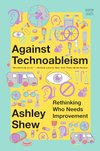
Saved by Flaming Fishbowl and
Against Technoableism: Rethinking Who Needs Improvement (A Norton Short)

Saved by Flaming Fishbowl and
When people posit disability as a problem, they look for solutions.
Today, many of our ideas about able-bodiedness and disability come from classifications based on who is suitable for plantation or factory work: we call people “disabled” when they can’t perform “normal” amounts of physical labor.
I consider disabled people the experts about disability. I’m no longer interested in what so-called experts (nondisabled
Lawrence Carter-Long has written beautifully about the etymology of the word “disabled,” pointing out the deep differences between the prefixes dis- and un-. As he points out, dis-abled is different from un-able. He talks how one meaning of dis- is “to twain.” In a popular Facebook note from 2015, he writes: Twain literally means “in different
... See moreThis trope implies that to be good disabled people, we have to be constantly fighting against our bodies or minds in some way.
Talila A. Lewis describes ableism as “[a] system that places value on people’s bodies and minds based on societally constructed ideas of normality, intelligence, excellence, desirability, and productivity.”
In the United States, the introduction of chattel slavery firmed up disability as a physical category, one centered on which bodies and minds have or generate
You’ll recognize in this entry the tension between the medical model, in which disability is the problem, and the social model, in which the built environment is the problem. It’s very clear which model the tech world subscribes to, with its expensive, complex solutions to the “problem” of not being able to walk. I think often about how these
... See moreMany of us want futures where disabled people don’t have to be pushed to normalize our mere-difference in order to make ourselves palatable enough—“includeable,” to use sociologist Tanya Titchkosky’s term.